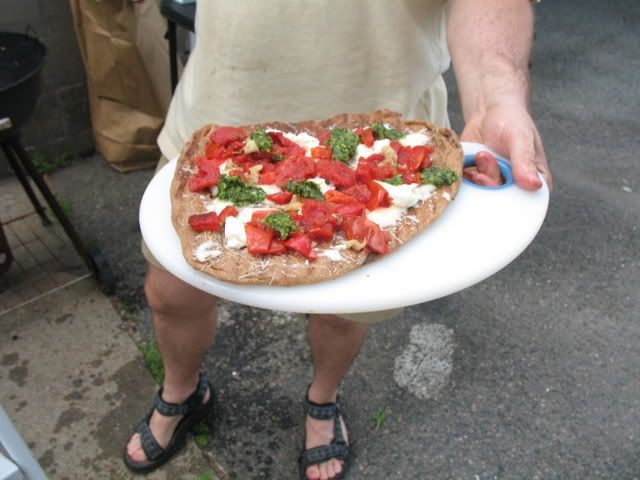Even in the midst of moving, a family’s got to eat. And with the beautiful summer weather we’ve been having in New England (70 degrees F, sunny, low humidity – ah, New England, I’m gonna miss ya), I’ve been cooking an awful lot on the grill, and I finally got around to making grilled pizza. Of course, I did it with whole wheat.
I don’t have the recipe in front of me, but if there’s interest, I’ll add it in the comments sometime later. All I can say is, Peter Reinhart’s advice in American Pie is easy to follow, and makes a fantastic pie. It’s surprisingly simple to do.
To make the pie whole wheat, I simply increased the amount of water by about 2-3 Tbs per cup. I downsized the recipe to make just two pies, and smaller ones at that. A 12-15 inch pie would be too large to fit on one side of the grill, which was a necessity, since I was using the one-grill method.
The key, it seems to me, really is to rake almost all the coals to one side so that there’s a blazing hot side and relatively cool side. I shaped my pies in a rough oval, because they fit better that way, but they got deformed because, even though I slathered the back of my baking sheet with olive oil, it was still not an easy task getting the dough off the sheet and onto the grill.
I was a little too worried about burning the dough. I could have left the second pie on the grill a little bit longer and gotten a better crust. But who’s complaining? It was excellent! For cheese, I used a 50-50 mozzarella-parmesan blend, and then added dollops of goat cheese. Toppings were roasted tomatoes, roasted red bell peppers and dollops of basil pesto.

We’ll be making these again.
Friday night, I’d started refreshing Arthur, my whole wheat starter, at 1-5-5, and did so again on Saturday morning, so by Saturday night, I had about 550 grams of starter at 100%. I decided to set up three things:
- Whole wheat sourdough hearth bread: 88% hydration with 5% of the flour pre-fermented as starter
- Whole wheat sourdough sandwich bread: 85% hydration with 10% of the flour pre-fermented
- Sourdough whole wheat English Muffins: I used this recipe for Sourdugh English Muffins, substituting whole wheat flour for the AP flour and adding 2 Tbs more milk. I used only 2 cups flour for the entire recipe. Good Lord these are easy!
When I woke up, I used what has come to be called “the French Fold” on both breads, and then set about making the English muffins. Did I mention that these are easy? And delicious?
Here they are set on the breakfast table:

And here’s one opened up. I was very pleased with the spongy interior!

I rolled these out a little thin, but they were still lovely. Plus I got 15 muffins, instead of just 12. Next time around, I’ll keep them thicker, though.
Here’s the whole wheat sourdough hearth bread we had for dinner. I was rushed when shaping, so I didn’t preshape and was a little rough. You can see the results in the crumb – not nearly as open as I’d like, but still good for dinner.

We had the bread with a delicious and quick-to-make
asparagus-spinich pesto over whole wheat linguini and a
white bean and spinach salad. (I like
101 Cookbooks a lot, and her cookbook,
Super Natural Cooking, is very good, but she uses a lot of exotic, hard-to-find ingredients. For the salad dressing, I just used some lemon zest, plain olive oil and cider vinegar, and it turned out fine.)
Last, the sandwich bread. I let it ferment a bit too long, but it nevertheless turned out just fine, if a little on the sour side (which my wife says is a feature, not a bug). The blur you see is my daughter’s hand grabbing the slice mid-shot. She’s a growing girl, what can I say?
